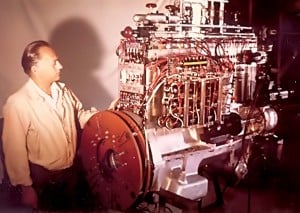 Infinite Energy Magazine issue #51 Joseph Papp’s Noble Gas Engine Rises from September/October 2003 reports comprehensively on the events surrounding the Hungarian-born Josef Papp‘s creation of an engine powered by plasma sparked from small amounts of noble gases.
Infinite Energy Magazine issue #51 Joseph Papp’s Noble Gas Engine Rises from September/October 2003 reports comprehensively on the events surrounding the Hungarian-born Josef Papp‘s creation of an engine powered by plasma sparked from small amounts of noble gases.
Many credible witnesses to the demonstrations, including aerospace engineers, defense contractors, and Navy researchers, were skeptical of the claims about this “wonder engine”, at first.
They came to be convinced the claims were true by the indisputable experimental facts before them: a lot of energy was being created, with no heat, no toxic emissions, and no understanding of how it was operating.

According to Papp, it was Feynman’s pulling of a plug that caused the deadly explosion, though Feynman speculated it might have been conventional explosives planted in the device.
Feynman was represented with his employer in the ensuing litigation and science institutional giant Caltech settled, never finding any evidence of any explosive material, chemical or otherwise. Caltech claims to no longer have records on the tragedy.
For a full story on the noble gas engine and its controversial inventor, read The Mystery and Legacy of Joseph Papp’s Noble Gas Engine by Eugene Mallove from IE issue #51.

The German-born engineer now lives in California and works with inventor Tamerlane Sanchez developing a line of multi-cylinder engines based on the pulsing of plasma generated from plain air. They call their core technology the Pulser.
Lightning Harnessed by Heinz Klostermann from IE #51 describes his engine design and how it differs from Papp’s.
The reaction begins when air molecules are momentarily ionized into a plasma and then hypothesized to collapse back to air molecules. A small 12Volt battery charges a capacitor providing 500 Volts across a pair of electrodes. When the air between the electrodes is ionized, the plasma allows current to pass through the electrodes, discharging the capacitor with each pulse.
Klostermann and Sanchez maintain that high-frequency cycling of this process up to the Megaherz range causes “plasma shockwaves” that translate into kinetic energy to move a piston. A moving piston can produce power for transportation or electricity.
“Controlling the plasma shockwave is the key, because then you have the ‘push’”, says Klostermann.

One afternoon in the end of August, I visited their lab in Palo Alto, California. Klostermann and Sanchez demonstrated a plasma engine core test unit, shooting a free piston outwards.
Flying alongside a board with squares, the speed of the piston could be computed, giving an estimate of its energy out of the chamber.
Klostermann believes the Pulser is over-unity, but admits that “more instrumentation is needed” before he “can definitely show it”.
Opening the door to new energy possibilities beyond cold fusion reveals an array of exotic technologies designed to extract energy from our surroundings. Some utilize magnets and gravity, some work to capture virtual photons from the quantum vacuum, and some use circuits and plasma sparks. Harvesting this always-available energy located in our ambient environment is the focus of “free energy” research.
While cold fusion may be the closest to becoming a usable product by the public-at-large, plasma pulse generators based on the work of Joseph Papp are closely paralleling development.
Like cold fusion, the lack of funding hampers efforts needed to both scale up and control the Papp reaction into a commercial product.
The lack of innovative and usable energy solutions from the current hardware monopolies are driving interest elsewhere, and the handful of companies currently working to make new energy generators a commercial reality are finding renewed interest and support.
The grassroots public is slowly awakening to aid the field with buzz and crowd-funding, replacing what should have been a Marshall Plan with a decentralized but spreading meme: There are an array of solutions to our energy problems, and we choose them now.
Related Links
The Dream Machine by David Ansley San Jose Mercury News August 1989 courtesy Rohner Group
Cold Fusion Now UPdate by Ruby Carat September 13, 2012
